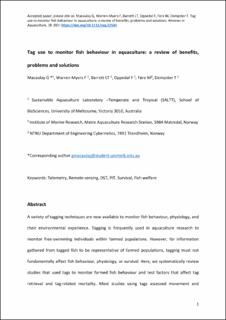Tag use to monitor fish behaviour in aquaculture: a review of benefits, problems and solutions
Macaulay, Georgia; Warren-Myers, Fletcher; Barrett, Luke T.; Oppedal, Frode; Føre, Martin; Dempster, Tim
Peer reviewed, Journal article
Accepted version
Permanent lenke
https://hdl.handle.net/11250/2827024Utgivelsesdato
2021Metadata
Vis full innførselSamlinger
Sammendrag
A variety of tagging techniques are now available to monitor fish behaviour, physiology and their environmental experience. Tagging is frequently used in aquaculture research to monitor free-swimming individuals within farmed populations. However, for information gathered from tagged fish to be representative of farmed populations, tagging must not fundamentally affect fish behaviour, physiology or survival. Here, we systematically review studies that used tags to monitor farmed fish behaviour and test factors that affect tag retrieval and tag-related mortality. Most studies using tags assessed movement and swimming behaviour in salmonids, predominantly in Europe and North America. Mortality of tagged fish was 10 times higher in sea-cages (mean = 25%, range = 0–61.5%, n = 22 studies) than in tanks (mean = 2.5%, range = 0–17%, n = 23 studies), while mortality of tagged fish in sea-cages was markedly higher in longer trials (from 4% in single day trials to 36% after 100 days). Higher-than-usual mortality rates among tagged fish, together with largely unknown sublethal effects on behaviour, should caution against using tagging studies to make decisions related to farm management. Moreover, key metrics such as mortality rates of tagged and untagged fish or evidence of sublethal effects are often unreported. We make several recommendations to improve future tagging studies and increase transparency in reporting. A greater insight into the causes of tagged fish mortality in sea-cages is required to secure animal welfare and data validity in studies that use tags to assess fish behaviour in aquaculture.
